Introducing the Deep Blue Pro Granular Shock, a powerhouse in pool water treatment designed to tackle even the toughest of pool water problems. These calcium hypochlorite granules boast an impressive available chlorine level of approximately 70%, making them a potent chlorine donor for your pool.
When it comes to restoring your pool water to its sparkling best after an algae infestation, the Granular Shock Chlorine is your go-to solution. Simply add it through the skimmer, and watch as it works its magic to combat algae and bring your pool water back to life.
Here’s a top tip for maintaining your pool’s water quality: after a thunderstorm, swiftly administer a 5mg/l dose of Deep Blue Pro Granular Shock Granules or Shock ‘n’ Floc Granules. Thunderstorms can introduce nitrogen into the atmosphere, which then gets washed into your pool by the rain. Algae thrive on nitrogen, potentially turning your pool water green. A timely shock dose of chlorine can help stave off this green invasion.
For effective application of the Deep Blue Pro Granular Shock, follow these step-by-step instructions:
1. Ensure your pool’s pH levels are within the ideal range of 7.2 ? 7.6. Adjust if necessary.
2. Maintain free chlorine levels between 1 ? 3 mg/l (ppm) regularly. Consider shock or oxidizing treatments on a weekly or fortnightly basis, with a maximum of 10mg/l (10ppm) for a full shock treatment.
3. Pre-dissolve the granules in a clean plastic container at a maximum rate of 100g per 2.2 gallons (10 litres) of water. Mix thoroughly to ensure complete dissolution before adding the solution to the pool with the pump running for optimal distribution.
4. Repeat the application if needed to reach your desired chlorine level.
5. Following treatment, your pool water may temporarily appear cloudy, so keep the filtration pump running until it clears up.
6. Allow the chlorine level to drop below 5ppm before resuming swimming activities, waiting at least 30 minutes after treatment.
Concerned about dosing rates? The table below provides a clear guide on the recommended amounts of the 70% Shock Chlorine Granules to use based on your pool’s water volume, ensuring you achieve the desired chlorine levels effectively.
| 70% Shock Chlorine Granules Dosing Rates |
| Water Volumes |
To Increase Pool Chlorine Level by |
| Litres |
Gallons |
1mg/L (1ppm) |
5mg/L (5ppm) |
10mg/L (10ppm) |
| 4,545 |
1,000 |
7g |
35g |
70g |
| 11,360 |
2,500 |
17g |
88g |
175g |
| 22,700 |
5,000 |
35g |
175g |
350g |
| 45,450 |
10,000 |
70g |
350g |
700g |
| 68,175 |
15,000 |
105g |
525g |
1050g |
When handling the Deep Blue Pro Granular Shock, keep these general precautions in mind:
– Wear eye and face protection during dosing to prevent any contact with your eyes.
– Avoid mixing with other chemicals, including cleaning products and chlorine-based substances, to prevent dangerous reactions.
– Do not pour the product into a pool skimmer basket containing other chemicals.
– Always add the product to water when pre-dissolving, not the other way around.
For safe handling and storage of the product:
– Handle the granules in a well-ventilated area, preferably outdoors.
– Wash your hands after use.
– Store the product in a cool, dry place to prevent moisture absorption.
It’s essential to be aware of the risks associated with the product:
– Contact with combustible materials may lead to fire.
– Ingestion of the product is harmful.
– Avoid contact with acids as it can release toxic gases.
– The product can cause burns on contact.
– It is very toxic to aquatic organisms and may have long-term adverse effects on aquatic environments.
Here are some safety guidelines to follow:
– Always use biocides safely and read the label and product information before use.
– Keep the product locked up and out of reach of children.
– If the product comes in contact with your eyes, rinse with plenty of water and seek medical advice.
– Wear appropriate protective clothing, gloves, and eye/face protection when handling the product.
– In case of an accident or if you feel unwell, seek immediate medical advice and show the product container or label.
– Avoid releasing the product into the environment and refer to the safety data sheet for detailed instructions.
With the Deep Blue Pro Granular Shock, you can trust that your pool water will be treated effectively and efficiently, ensuring a safe and enjoyable swimming experience for you and your family. Say goodbye to pool water problems and hello to crystal-clear, pristine waters with this exceptional chlorine shock treatment.
Manufacturers description:
Deep Blue Pro Granular Shock – A traditional shock treatment product, these calcium hypochlorite granules have an available chlorine level of on average 70% making them a good chlorine donor for pool water problem solving.
Granular Shock Chlorine is very effective at restoring sparkling water from algae infestation.
Granular Shock Chlorine can be added through the skimmer.
Top Tip:As soon as possible after a thunderstorm shock dose your pool with a 5mg/l dose of Deep Blue Pro Granular Shock Granules or Shock ‘n’ Floc Granules.
The reason for this is that lightening creates nitrogen in the atmosphere and the rain washes this nitrogen into your pool. Nitrogen is plant food and algae thrive on it, so pool water can quickly turn green after a thunderstorm, a shock dose of chlorine can help prevent this.
Application Instructions:1. Maintain pH levels within the ideal range of 7.2 – 7.6. If the level is not in this range, adjust accordingly.
2. Maintain free chlorine residuals routinely in the 1 – 3 mg/l (ppm) range. Shock or oxidising procedures are recommended either weekly or fortnightly with a maximum of 10mg/l (10ppm) for a full shock treatment.
3. Pre-dissolve this product in a clean plastic container at a maximum rate of 100g of product per 2.2 gallons ( 10 litres) of water. Stir well to ensure product is fully dissolved. Add the resulting solution to the pool whilst the pump is turned ON preferably near the water inlets to aid distribution.
4. Repeat dose/application if necessary to achieve the desired level.
5. After using this product, pool water may become temporarily cloudy, so keep the filtration pump running until it clears.
6. After shock treatment procedures allow the chlorine to drop below 5ppm before bathing recommences and in any event wait for at least 30 minutes before bathing recommences.
| 70% Shock Chlorine Granules Dosing Rates |
| Water Volumes |
To Increase Pool Chlorine Level by |
| Litres |
Gallons |
1mg/L (1ppm) |
5mg/L (5ppm) |
10mg/L (10ppm) |
| 4,545 |
1,000 |
7g |
35g |
70g |
| 11,360 |
2,500 |
17g |
88g |
175g |
| 22,700 |
5,000 |
35g |
175g |
350g |
| 45,450 |
10,000 |
70g |
350g |
700g |
| 68,175 |
15,000 |
105g |
525g |
1050g |
General Precautions:
Dosing:Wear eye and face protection and ensure granules are not blown back into your face.
Never mix with any other chemicals including cleaning products and chlorine products, as a dangerous reaction will occur.
Do not pour this product into a pool skimmer basket containing chlorine tablets or any other product.
When pre-dissolving product always add product to water not the other way round.
Handling & Storage:Handle products in a well-ventilated area, preferably outdoors.
Wash hands after use.
Ensure chemicals do not become damp in storage – store in a cool dry place.
This Granular Shock contains Calcium Hypochlorite 70% CL Active – EC Label 231-908-7 UN3487
Risk:– Contact with combustible material may cause fire.
– Harmful if swallowed.
– Contact with acids liberates toxic gas.
– Causes burns.
– Very toxic to aquatic organisms, may cause long term adverse effects in the aquatic environment.
Safety:
– Use Biocides safely. Always read the label and product information before use.
– Keep locked up and out of reach of children.
– In case of contact with eyes, rinse immediately with plenty of water and seek medical advice.
– Wear suitable protective clothing,gloves and eye/face protection.
– In case of accident or if you feel unwell seek medical advice immediately and show this container or label.
– Avoid release to the environment.
– Refer to special instructions/safety data sheet.
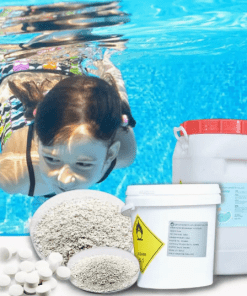 Hydrogen Peroxide 35% for Water Treatment & Cleaning [600kg]
1 ×
Hydrogen Peroxide 35% for Water Treatment & Cleaning [600kg]
1 × Deep Blue Professional - 200g STABILISED Chlorine Tablets 25kg SLOW RELEASE
1 ×
Deep Blue Professional - 200g STABILISED Chlorine Tablets 25kg SLOW RELEASE
1 × Deep Blue Pro Kiddy Pool Care Sachet
1 ×
Deep Blue Pro Kiddy Pool Care Sachet
1 ×
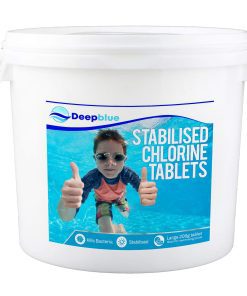 Deep Blue Professional - 200g STABILISED Chlorine Tablets 25kg SLOW RELEASE
Deep Blue Professional - 200g STABILISED Chlorine Tablets 25kg SLOW RELEASE 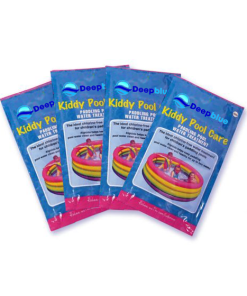 Deep Blue Pro Kiddy Pool Care Sachet
Deep Blue Pro Kiddy Pool Care Sachet 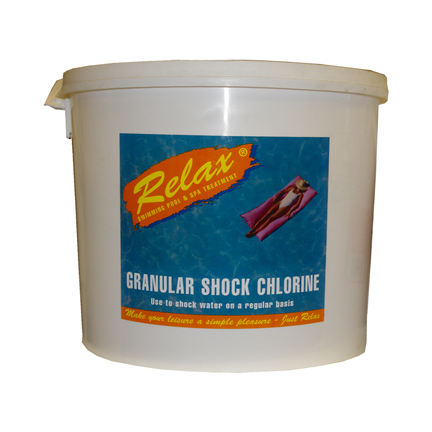


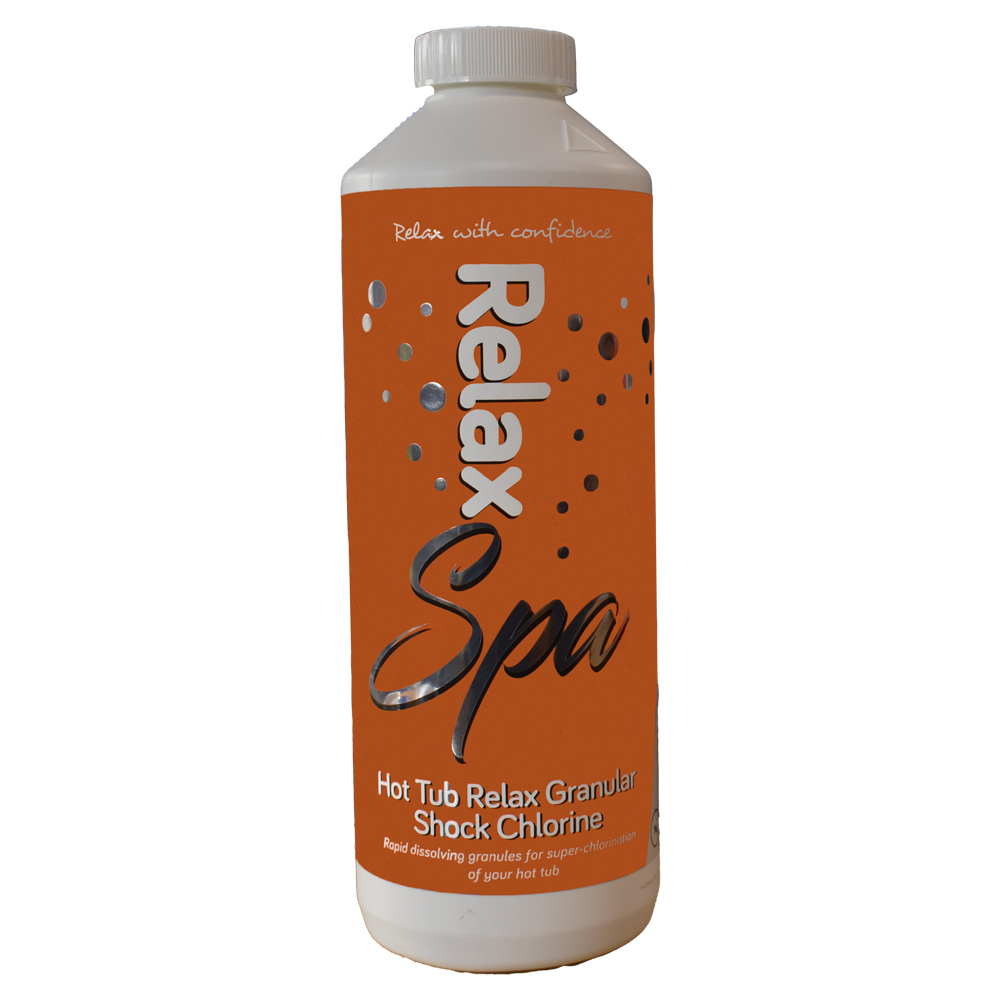
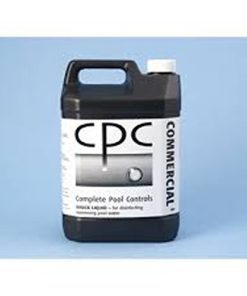

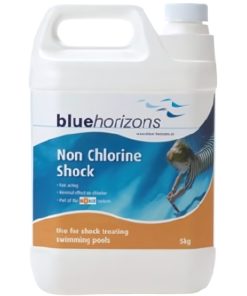
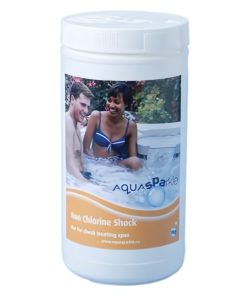


Tuci (verified owner) –
Dont go by the picture